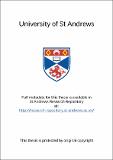Multi-dimensional modelling of physiologically and temporally structured populations
Abstract
Physiologically-structured population counts are sometimes the only available source of information about a population. Because such data are often sparse and noisy, they are difficult to model. Moreover the parameters of interest may be underlying demographic rates rather than population abundance. In this thesis, the possibility of using smoothing splines, demographic processes and environmental variables to improve estimates of birth and death rates from physiologically-structured population counts is explored.
A smooth physiologically-structured population model is proposed which makes appropriate use of demographic processes and allows explicit space-time dependence in estimated quantities (birth and death rates). A model fitting process is also defined. The model is tested using simulated data and is applied to Dover sole (Solea solea) data from the Bristol Channel. It can be applied when the life-history stages are defined by age. The method presented avoids mis-specification bias in birth and death rate estimates and improves their precision. It allows study of the relationship between vital rate estimates and environmental variables and, when coded, is straightforward to apply.
The more general inverse problem of obtaining birth, death and growth rates from stage abundances is also examined, when the physiological trait distinguishing stages need not be age. It is proven mathematically that unique solutions do not exist unless the trait is age, though limits for the growth and hence birth and death rates do exist when the growth rate is independent of the physiological trait. Simulations are used to demonstrate that plausible estimates of the 'true' birth, death and growth rates, cannot be identified in practice.
To overcome this difficulty, stage-age experiment data may be incorporated into physiologically-structured population models. A new method is discussed for doing this in a statistically justified manner.
Type
Thesis, PhD Doctor of Philosopy
Collections
Items in the St Andrews Research Repository are protected by copyright, with all rights reserved, unless otherwise indicated.

